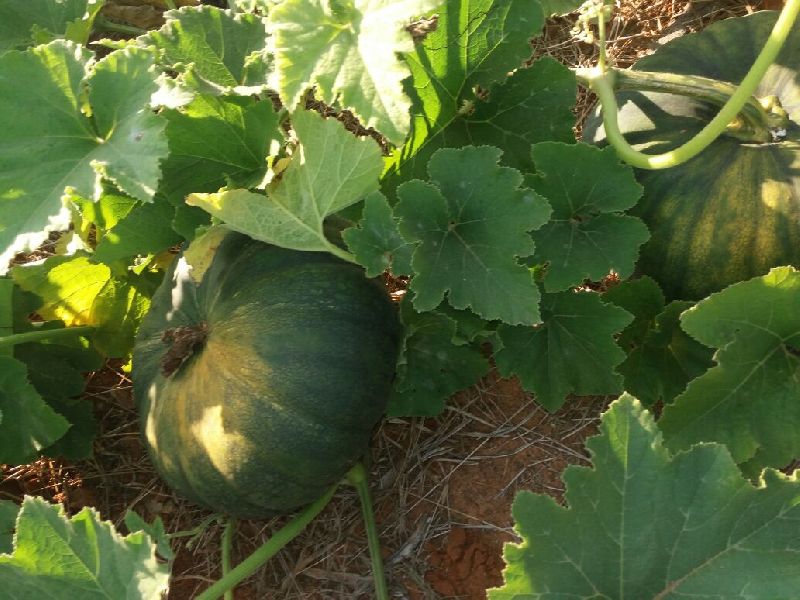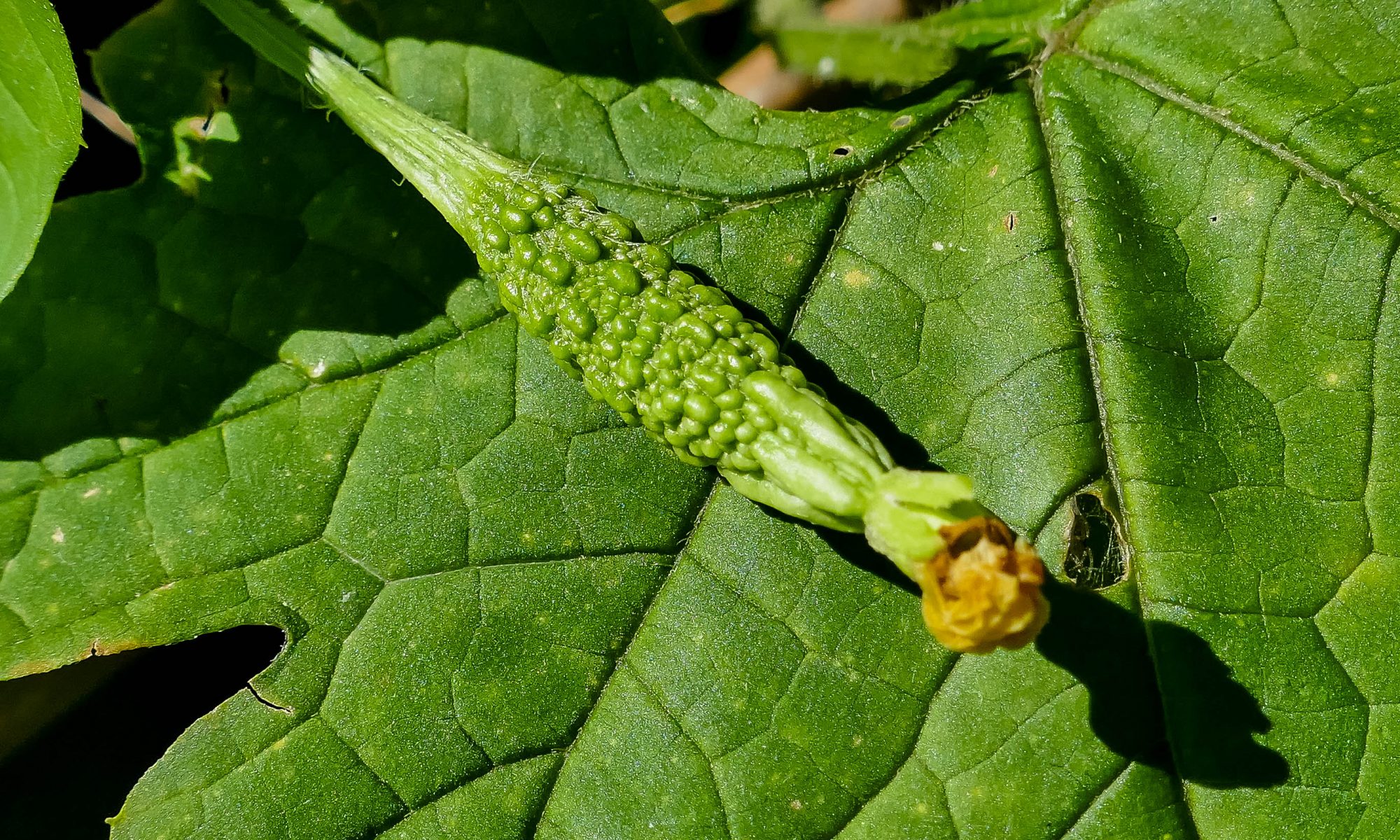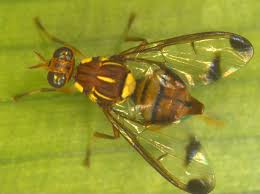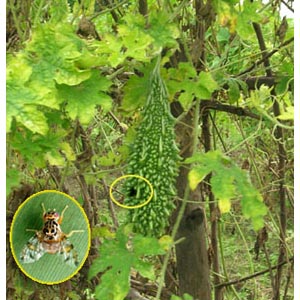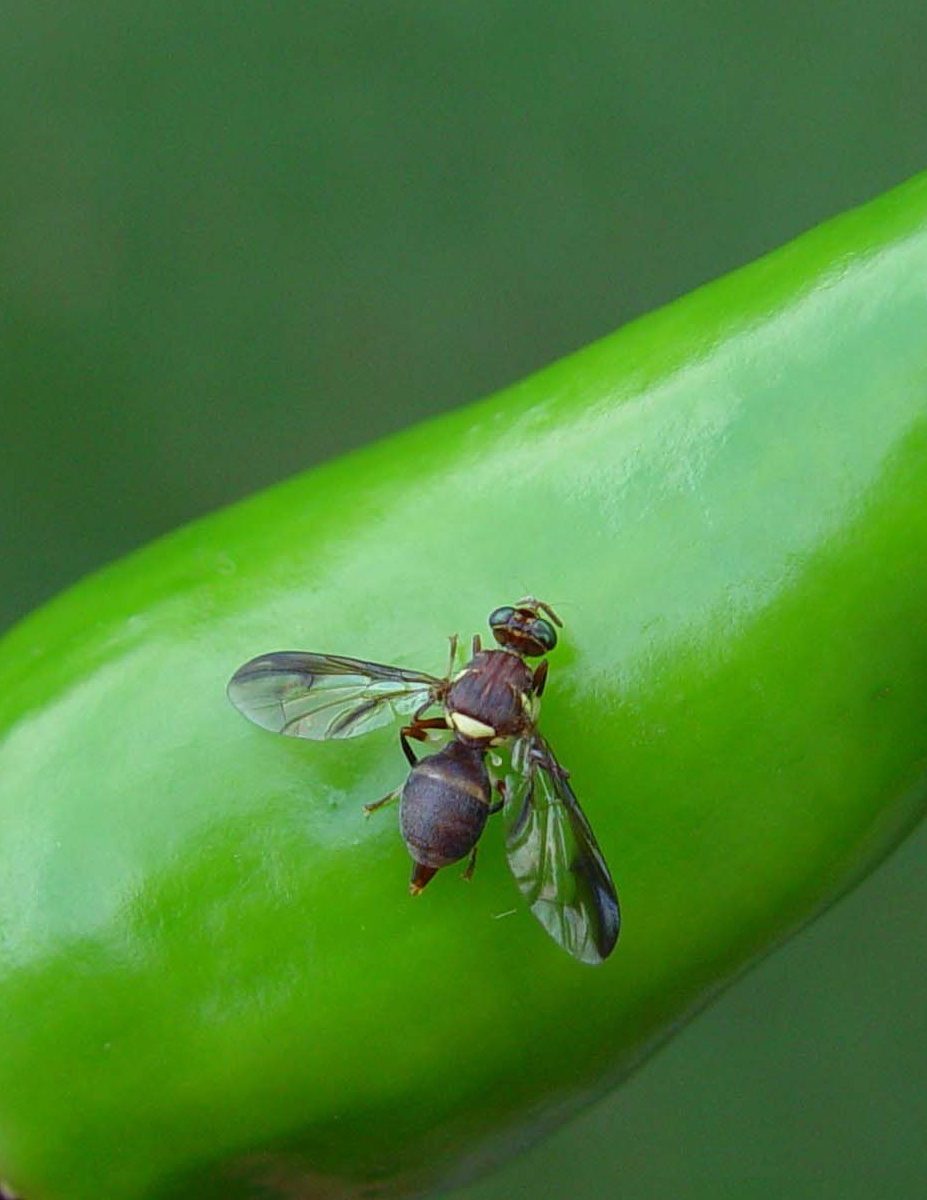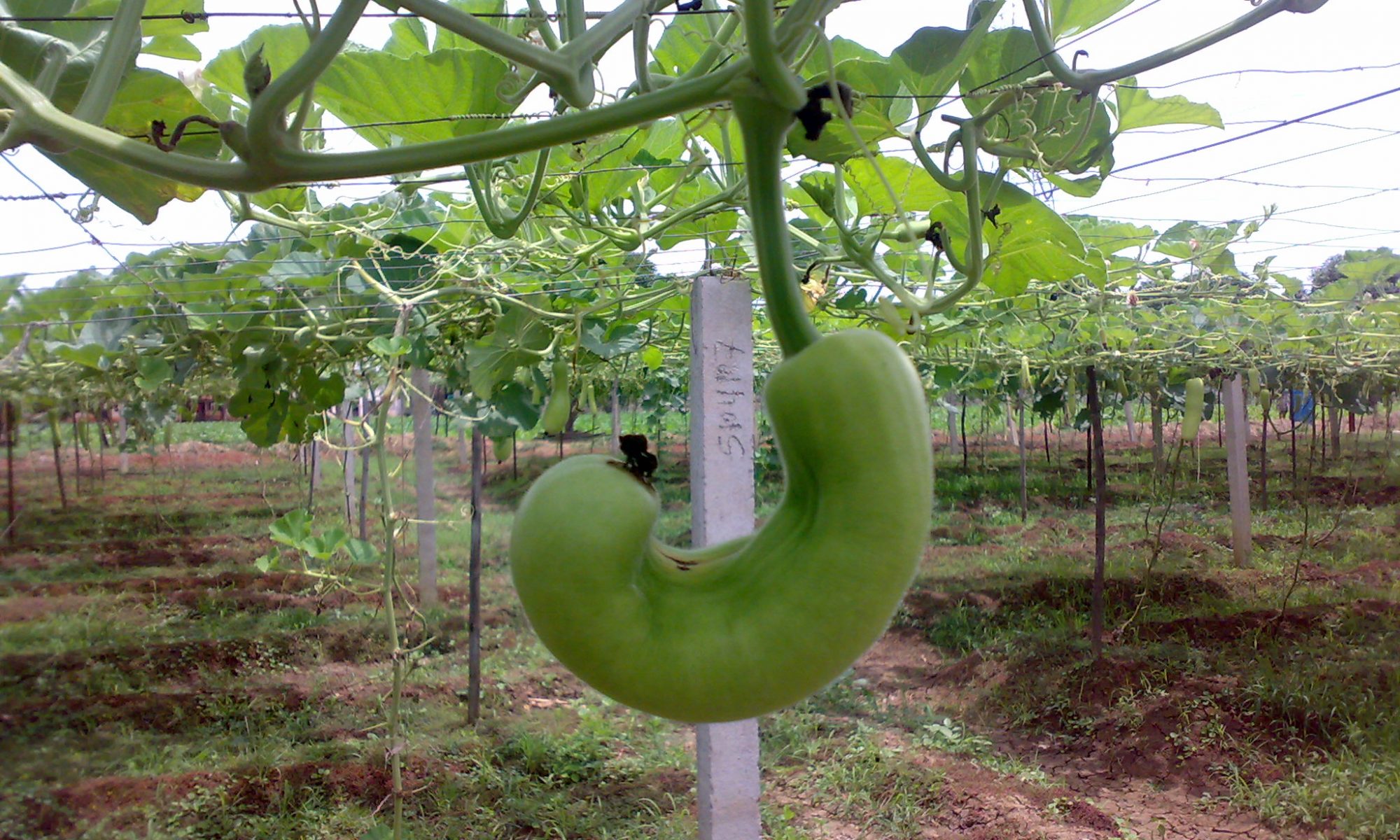- Collect and destroy infested fruits.
- Flytraps (pheromone traps) can be set to prevent egg-laying by fruit flies.
- Maize plant s grown in the field are effective as flies rest on such tall plants.
- Deep ploughing should be done to expose hibernating stages of fruit flies.
- spray dichlorvos 76% EC 250 to 500ml/acre or
- Lambda Cyhalothrin 4.9% CS @ 200 ml/acre. or
- Profenofos 40%EC + Cypermethrin 4 %EC @ 400 ml/acre
Identification of fruit fly on pumpkin
- The worm bores into the fruits and sucks the sap.
- Infected fruits fall after decaying.
- These flies prefer tender fruits for egg-laying.
- The fly bore a hole into the fruit to lay her eggs inside it. Fruit Juice can be seen coming out from these holes.
- This also results in distorted and malformed.
- The maggots feed on the pulp of fruits as well as on the immature seeds and cause premature dropping of fruits.
Management of fruit fly in bitter gourd
- Collect and destroy infested fruits.
- To prevent egg-laying, fly traps(pheromone trap) can be set up in the field with 1% Methyl Eugenol or Citronella oil or Vinegar or Dextrose or Acetic acid or Lactic acid.
- Cover developing fruits with paper or polythene cover immediately after anthesis pollination.
- Maize plants grown in rows at a distance of 8-10 cm in the field is effective as flies rest on such tall plants.
- Deep plowing to expose hibernating stages.
- spray dichlorvos 76% EC 250 to 500ml/acre or
- Lambda Cyhalothrin 4.9%CS @ 200 ml/acre. or
- Profenofos 40%EC + Cypermethrin 4 %EC @ 400 ml/acre
Like and share with other farmers by clicking on the button below.
ShareManagement of fruit fly in bitter gourd
- Collect and destroy infested fruits.
- To prevent egg-laying, fly traps(pheromone trap) can be set up in the field with 1% Methyl Eugenol or Citronella oil or Vinegar or Dextrose or Acetic acid or Lactic acid.
- Cover developing fruits with paper or polythene cover immediately after anthesis pollination.
- Maize plants grown in rows at a distance of 8-10 cm in the field is effective as flies rest on such tall plants.
- Deep plowing to expose hibernating stages.
- spray dichlorvos 76% EC 250 to 500ml/acre or
- Lambda Cyhalothrin 4.9%CS @ 200 ml/acre. or
- Profenofos 40%EC + Cypermethrin 4 %EC @ 400 ml/acre
Like and share with other farmers by clicking on the button below.
ShareFruit Fly in bitter gourd
- The maggot burrows into the fruits and sucks the sap.
- Infested fruits decay and drop.
- They fly mainly prefer tender fruits for egg-laying.
- Ovipositional punctures caused by adults also cause injury on fruits and fruit juices oozes out.
- This also results in distorted and malformed.
- The maggots feed on the pulp of fruits as well as on the immature seeds and cause premature dropping of fruits.
Like and share with other farmers by clicking on the button below.
ShareManagement of fruit fly in bottle gourd
- The maggot burrows into the fruit and feeds on fruit pulp.
- Infested fruits decay and drop.
- They fly mainly prefer tender fruits for egg-laying.
- Ovipositional punctures caused by adults also cause injury on fruits and fruit juices oozes out.
- Collect and destroy infested fruits.
- To prevent egg-laying, fly traps(pheromone trap) can be set up in the field with 1% Methyl Eugenol or Citronella oil or Vinegar or Dextrose or Acetic acid or Lactic acid.
- Cover developing fruits with paper or polythene cover immediately after anthesis pollination.
- Maize plants grown in rows at a distance of 8-10 cm in cucurbit field is effective as flies rest on such tall plants.
- Deep plowing to expose hibernating stages.
- spray dichlorvos 76% EC 250 to 500ml/acre or
- Lambda Cyhalothrin 4.9%CS @ 200 ml/acre. or
- Profenofos 40%EC + Cypermethrin 4 %EC @ 400 ml/acre
Like and share with other farmers by clicking on the button below.
ShareControl of fruit fly in snake gourd
- The maggots burrow into the fruits and suck the sap.
- Infested fruits decay and drop.
- The fly mainly prefers tender fruits for egg laying.
- Ovipositional punctures caused by adults also cause injury on fruits and fruit juices oozes out.
- Collect and destroy infested fruits.
- Cover developing fruits with paper or polythene cover immediately after anthesis pollination.
- Maize plants grown in rows at a distance of 8-10 cm in snake gourd field is effective as flies rest on such tall plants.
- Soil incorporation of carbaryl 10% dust can be made in fruit fly endemic areas.
- Spraying of Dichlorovas @3 ml/lit of water at fortnightly intervals.
- Deep ploughing to expose hibernating stages.
Like and share with other farmers by clicking on button below.
ShareManagement of fruit fly in bottle gourd
- The maggot burrows into the fruits and sucks the sap.
- Infested fruits decay and drop.
- The fly mainly prefers tender fruits for egg laying.
- Ovipositional punctures caused by adults also cause injury on fruits and fruit juices oozes out.
- Collect and destroy infested fruits.
- To prevent egg laying, fly traps(pheromone trap) can be set up in the field with 1% Methyl Eugenol or Citronella oil or Vinegar or Dextrose or Acetic acid or Lactic acid.
- Cover developing fruits with paper or polythene cover immediately after anthesis pollination.
- Maize plants grown in rows at a distance of 8-10 cm in cucurbit field is effective as flies rest on such tall plants.
- Soil incorporation of Carbaryl 10 % dust can be made in fruit fly endemic areas.
- Deep ploughing to expose hibernating stages.
- spray dichlorvos 76% EC 250 to 500ml /acer
Like and share with other farmers by clicking on button below.
ShareControl of Fruit fly in Sponge Gourd
Fruit fly in Sponge Gourd:-
- The maggot burrow in to the fruits and suck the sap.
- Infested fruit decay and drop.
- The fly mainly prefers tender fruits for egg laying.
- Ovipositional punctures caused by adults also cause injury on fruits and fruit juice oozes out.
- This also results in distorted and malformed.
- The maggots feed on the pulp of fruits as well as on the immature seeds and cause premature dropping of fruits.
Control:-
- Collected and destroy infected fruits.
- To prevent egg laying fly traps (Pheromons traps) can be set up in the yield with 1%methyl Engenol or Cintronella oil or vinegar or dextrose or Acetic acid or laetic acid.
- Cover developing fruits with paper or polythene cover immediately after anthesis pollination.
- Maize plants grown in rows at a distance of 8-10 cm in sponge gourd field is effective as flies rest on such tall plants.
- Soil incorporation of cabaryl 10% dust can be made in fruit fly endemic areas.
- Spraying of Dichlorovas @3ml/lit of water at fortnightly intervals.
- Deep ploughing to expose hibernating stages.
Like and share with other farmers by clicking on button below.
ShareControl of Fruit fly in Bitter Gourd
Identification:-
- Egg are 1 to 1.5mm long whitish in colour, elongate cylindrical in shape. Slightly curved and tapering at both ends.
- Full grown maggot are 5 to 10 mm. long cylindrical in shape, tapering an teriorly an blunt at posterior end and pole white in colour.
- Pupae are 5 to 8mm long, barrel shaped and brown to ochraceous in colour.
- Adult fly has reddish brown body with transparent and shiny wings. Bearing yellow- brown streaks.
- Adult fly are 4 to 5mm long having a wings expanse of 11 to 13 and 14 to 16mm in males and females respectively.
Damage:-
- The maggot burrow in to the fruits and suck the sap.
- Infested fruit decay and drop.
- The fly mainly prefers tender fruits for egg laying.
- Ovipositional punctures caused by adults also cause injury on fruits and fruit juice oozes out.
- This also results in distorted and malformed.
- The maggots feed on the pulp of fruits as well as on the immature seeds and cause premature dropping of fruits.
Control:-
- Collected and destroy infected fruits.
- To prevent egg laying fly traps (Pheromons traps) can be set up in the yield with 1%methyl Engenol or Cintronella oil or vinegar or dextrose or Acetic acid or laetic acid.
- Cover developing fruits with paper or polythene cover immediately after anthesis pollination.
- Maize plants grown in rows at a distance of 8-10cm in cucurbit field is effective as flies rest on such tall plants.
- Soil incorporation of cabaryl 10% dust can be made in fruit fly endemic areas.
- Spraying of Dichlorovas @3ml/lit of water at fortnightly intervals.
- Deep ploughing to expose hibernating stages.
Like and share with other farmers by clicking on button below.
Share
